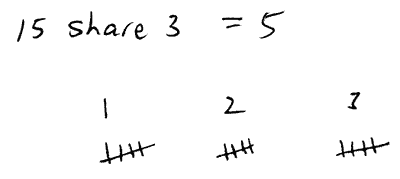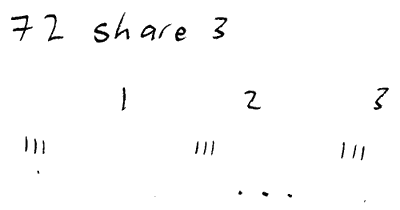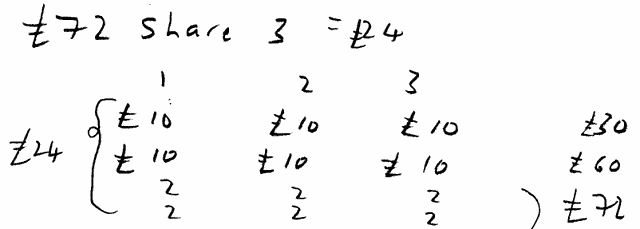
[ home ]
Students can use calculators in the Functional skills maths exams at level 1 and level 2. I still teach paper and pencil calculation methods as we go along because I think it helps understanding, but also because many institutions use diagnostic tests for entry to more advanced courses. Diagnostic tests tend to emphasise paper and pencil methods. Many students find division challenging.
A student of mine called P (because that has nothing to do with her name) divides by sharing out. The example below is my use of P's method to divide 15 by 3.

72 ÷ 3 cropped up in a question. P was in for the long haul...

At that point, I had a brainwave; money. So the question became £72 shared by 3. I suggested using £10 notes first and checking the total after each 'round' of sharing. When we got to £60, I suggested £2 coins. Then the total reached £72 so we added up one share to £24.

I then did the sum using the standard division algorithm, explaining the 3 into 7 stage as taking two tenners for each of the three people and leaving one tenner over. The carry one to next place was cashing in the tenner for 10 pound coins and putting them with the two coins. Then we divide 12 by 3 again (counting up if needed).
I could use P's method of dividing by sharing when we get to ratio questions. Just circle two columns for me, and then circle one column for you. I get £48 and you get £24.
Most adults have schemata for dealing with money firmly in place. The calculation 1 - 0.35 came up in the context of probability in a GCSE class not so long ago. A few confused faces, so just I asked 'how much change do you get when it costs 35p and you give a pound coin? 65p comes back at the speed of light, so then I asked 'how would that be printed on a till receipt'? 0.65. Done.
I use the level 1 adult numeracy tests as quick practice for non-calculator maths, they are still available on the Move On Web site. The online versions of the tests allow students to work at home on their own computer and get instant marking and feedback! The practice at reading the questions carefully helps with Functional Skills proper.
A Maths teacher somewhere in Manchester or Salford has produced a series of YouTube videos covering the basic methods for whole numbers, fractions and decimals. The username is 'psychosides' on YouTube. There is an audio commentary, but one GCSE student a couple of years ago decided to use the videos with the sound turned down as he could anticipate each step.
Shaun Bailey has collated a whole lot of methods into the Functional Maths and Numeracy Study Guide available as a pdf on the skillsworkshop Web site. I keep a few copies of this in the classroom and students dip in as they want methods.
Keith Burnett, Last update: Sun Mar 03 2013